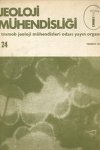
ABSTRACT: Üh@ study area to at th© Northwest of Valkifktty which belongs tô Tovos, Denizli at the Southwest AnatoMa, Oopper mlneralizatioıı occurs in the quarte-ffwuscovlte-CÄlcicMst belongtog to Pateossofe formation». In tWte formation, at Vt cuffearent places, copper mme^alizäMon are prospected and mapped. According to reserve calcutottwi», It was seem that 46 170 tons of or© with %O.0 Ou is found at our research area. In order this copper deposits to be worked, new reserves should to© cüsçoveri* For this purpose a geoeheinkiil prospecting had been done In th© In,vestfga1lon< area, primary and secondary dispersion pattern of Oti elêm©iit to the wall rock wa« studied
ABS TRACT: To find the percentage of anlon« and cations takes tun« on the trilfeear and shaped diagram®, wMch have been used for the classification of natural waters. The proposed .classification in this paper, the allions and cations are designated with capital and small letters (A = HOO~3 + CO- , B = 8O-4, O = Cl-, a = Oa++, b = Mg++, c = Na+ K+)è The dtemönd»»haped dlagram » Is `subdivided in to nine area and denoted with roman numbers. The anton`s aM cation`s triMeear diagrams are split up In to seven groups and six subgroup Each group and subroup possess thirteen class. The groups and class are defined in order by the ani ons and by the cations. Hence, one hundred sixty nine class appear. In the classification, the percentage of ions is follow by order of growth and labeled by a staple formula, Ions of less than 80%, are not displayed in the formula, Cheraical properittos of several analysis of water can be easily identified by this classification. For example, sea water Is labeled as C-lXc in the.
ABSTBACT: İn Körlü (Tarsus-Memn) region, the sedimeııts of Neogene ag#, uncomtfownaMy laveDlle the sediments of Upper Paleogene age. These sedjment®, hmmg 280 maters of totol tWetoess/ are divMed in to three FormattTOs, which contain the mollusc fauna of the Tethys basto and are named, from bottom to top as follows : Karaisalı Formation (Burdigalian) Kuzgun Formation (Tortonian) Memîşlî Formation (Messinian) The rich marine mollusc fauna such as t Conus (Cheiyconus) pyrula Brocchî var, mucromata Erentöz, W&B Strombus (Strombus) coronatus (Defrance in Basterot), 182^ CrasEOstrea gryi>hoides (Schlothelm), 1818 are well developped M Tortonian age. It is accepted that, starting from the Late Tortonian age, the marune properties of the region have been disappeared by the first oeeurence of Pirenella picta in töne. These Forinatlons are overlain by the continental sediments of PMoeene age.
ABSTBAGT: Plio-Qiiartery travertine are located in the areas of 6B0 Kml on the Antalya plain, Travertine », composed of ealeiiimaarbanate oomponent, ar© the product of secondary precipitates., Travertines whltoh are also fownad at the present show four different types according to the environmental condition. The poro §Ity, water sucking and pêrmability of these travertines are abundant. Massive and plant-tissue massive travertin« COB be used as building material without strength and making lime.
ABSTBACT: In 19Î4, thıoHte wm detected for the first tim© to the aHupdolom* (Oa^) md In Urn Hafc tendoloniit (Öa^) of the MMle ZeçhaWnformattôn near Eschwege âJad Sontra, He§aia# It was confirmed by means of dHlifog, chemical sad geochemlc^ MvesttgaMtons that m& fluorite to t^ HaupWolomit to stratabouiidL It occurs both locally to the İmm af macroscopic dark layer» mé lenses of up to 0.5 m thtog« aess smä moréoften, as mmm up to 1MÖ m thldte # É cannot maçroscopleaJly be distingulslied from the greyMt wMte dolomite without fluorite because of the low OaF# content (less tton 10 %), The fluorite contents vary between 10 and 50% OaF^ in the dark black layers. Bpedal^mples may contain op to 80 ^ OaFfl. The to^k colour derlvespartly firona the Mac fluorite but to a. greater degree fram bitumons material. Fluolrte has also been detected to the stmttgraphically hlgber Plattendolomit (Oa.,) of the Letae-iert. ei z S, Outcrops and quarries near Sontoa have local contenta of 1=4 % OàF|É The macroscopic and microscopiö toterstratiflcâtton of fluorite and dolomite with clear layer textures ani the absence M hydrothermal fluorite and other minerals in veins of fissures are evidence for a synsedimentary formation of the fluorite to the Hauptdolomlt (Caf) and the Plattendolomit (Ga.5)# The Ha~ aptdolomit to thought to have developed during late diagenesîn. This should be valid for the flmorlte, too* SlmMow lagoons M a saliiar facles are thought to have been the depositional environment. The fluorite precipitated from the sea water», which ware apparently endlched to fluorine byerosion at the fluorine rich granite» of the Harz m©ıratato§# Warn Is the only obvious explaantion o fthe large amounts of fluorine m the Zechsteta dolomite, estimated at 5J? s l^fconnes aFr

 TMMOB
TMMOB